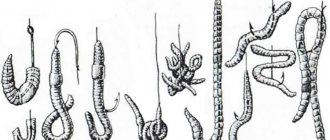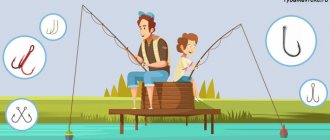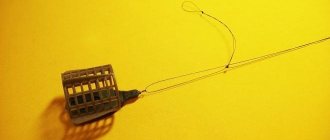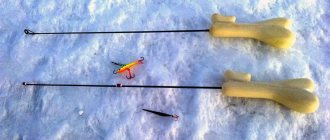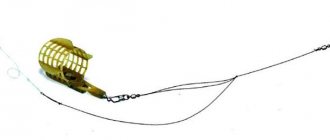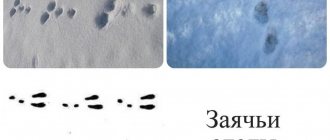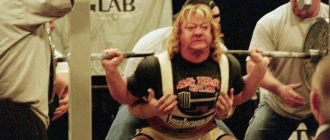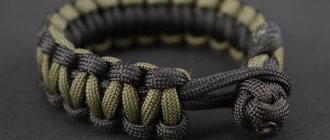Conical top
There are two main types of top fishing: with and without bait.
The second method (without bait) is used in the spring and is based on the fact that many fish need hard objects during spawning to rub against them, squeezing out eggs and milt. Naturally, for a good catch, you need to know perfectly well where and when the underwater inhabitants of the body of your choice spawn.
However, fish such as pike, crucian carp, and carp spawn in the shallows and give away the spawning site with noisy splashes, signaling that a fish placed here will not be left without a catch.
Finding a spawning ground, for example, for perch, is much more difficult. L.P. Sabaneev advised in such cases to create artificial spawning grounds by lowering piles of stones, piles of brushwood and felled young trees with a tied load to the bottom, and then, with the beginning of spawning, to cover this artificial spawning ground with nets and place the tops directly between the flooded trees.
Many supporters of fishing exclusively with fishing rods and spinning rods have the opinion that fishing with nets during spawning is destructive for the fish population and can very quickly turn any body of water into a fishless desert. But since we remembered Sabaneev, it would not be out of place to cite the classic’s opinion on this matter (he certainly cannot be classified as an apologist for predatory fishing).
So:
“...Fishing during spawning is usually considered harmful for reproduction and unprofitable for proper fish farming, but this opinion in reality - in practice - is not always true, and, it seems to me, there is no reason to unconditionally prohibit fishing during spawning. Only destructive methods of fishing are always harmful - in spring and winter - when the fish is caught outright - adults along with small things, when a more or less significant part of the fish dies in vain, for example, when “purging” or fishing with a samoder on bare hooks, when fighting with a spear, when Finally, the fish going to the spawning site are blocked by braids and are caught entirely.
Fish does not hatch or feed children, and the number of its eggs is counted in the thousands and tens of thousands, and therefore protecting fish in the spring cannot have the same meaning as protecting four-legged and feathered game. The whole point is that some of the eggs are safely swept out, and therefore fishing before spawning is more harmful than during spawning. Some fishing methods even have a positive effect on increasing the number of fish; such, for example, is fishing both with various top-shaped shells and with nets around those arranged to attract rubbing fish and more successful fishing with artificial spawning grounds, rowing, etc., in the form of piled brushwood, spruce branches, piles of stones. Wooden top-shaped gear even in itself represents bait for fish, an artificial spawning ground, and under the condition of a more or less long stay under water, a mass of young fish hatch from the eggs stuck to the walls of the top.
The validity of this view of the insignificance of the harm of spring fishing and the irrationality of its unconditional prohibition can be proven by the fact that the main catch of some fish is carried out precisely during spawning; In some places it is possible only during this period. Pike, for example, is caught mainly in the spring, when it spawns, and shortly thereafter.”
Well, what else can I add? In my opinion, a completely comprehensive and reasoned opinion. However, let's return to fishing with tops.
The method of spring fishing under consideration is that the top does not lure fish as a convenient object for freeing them from caviar and milt, but stands with its open “throat” in the way of fish hurrying to the spawning site, or having spawned and returning to their usual habitat. In this case, fishing is no different from fishing with a “sleeve” or nets without wings (see the relevant sections).
Summer fishing with tops, as already mentioned, is mostly carried out using a variety of baits. The most classic case is fishing in crucian ponds, when the bait is pieces of dried black or white bread flavored with unrefined (more aromatic) sunflower oil. Fishing is the simplest, and there are almost no misfires in it, even if the top is placed away from the usual feeding areas of crucian carp - sooner or later they will come there, attracted by the smell of bait. However, the size of the catch from such fishing is depressing - mostly crucian carp weighing from 30 to 50 g. To catch more crucian carp with tops, you should follow the following simple rules.
First, choose the right body of water. In semi-flowing ponds, where, in addition to crucian carp, predatory fish (perch, pike) also live in sufficient quantities, crucian carp almost never go to the top with bait, being caught rarely and by chance - on such reservoirs it is worth using other gear. In ponds where, in addition to gold carp, there are also silver crucian carp, fishing with tops is also not very effective. The fact is that in such a reservoir the population of silver crucian carp usually exceeds the population of gold crucian carp in both the number and size of fish, but large silver crucian carp do not make it to the top, only gold and small silver carp are found.
Thus, the best pond for catching crucian carp with tops is one inhabited exclusively by golden crucian carp, and not of small size.
Golden crucian carp is very tenacious and can breed in any hole, in a funnel filled with water, but forms a dwarf form there; Only a few specimens – the patriarchs of the crucian tribe – reach a weight of 150–200 g or more, and it makes no sense to hunt for them. The presence of rotan in the pond (the eternal companion of crucian carp in our time) does not have a significant effect on fishing with tops, according to my observations. (Amur sleeper itself is found rarely and by chance; mostly, fairly large specimens of rotan enter the fine-mesh tops, attracted by small crucian carp or verkhovka, if it is found in a reservoir.)
Secondly, to catch the tops of large crucian carp, it is worth covering the tackle with a net with a larger mesh (40 mm, in places with very large crucian carp - 45–50 mm). Then you won’t have to waste time shoveling a pile of unnecessary stuff out of the top. In this case, the bread bait should be placed in the top in a separate bag made of fine mesh or tulle, otherwise the bread, when soaked, will float through the large meshes. In addition to bread baits, all kinds of cakes are also used.
Thirdly, the top should not be placed blindly, but in those places where large crucian carp tend to feed. You can “feel” for such places with a fishing rod, best at dawn (the bite of large crucian carp is often short-lived, and an hour or two after dawn in the summer only small things begin to bite). You can determine the feeding places of large crucian carp at night by ear - the fish gives out its “tables” with splashes and chomping sounds, clearly audible in the silence of the night. If it was not possible to carry out preliminary reconnaissance of the reservoir, it is necessary to place the tops on the border of dense aquatic vegetation and clean water.
By following these simple rules, you can achieve stable catches of 2–3 kg of gold crucian carp per day from the top (and quite large ones, 250–400 g).
The heaviest specimens, over a kilogram, practically do not fall into the tops, and other gear is used to catch them.
It was said above that silver crucian carp almost never goes to the top with bread bait. However, as with many other rules, there are exceptions to this too.
In the spring (in the North-West of Russia - at the end of April or beginning of May, depending on the terrain and weather), the silver crucian carp, just emerging from hibernation and hungry, wanders in dense schools around the reservoir in search of food. If such a flock approaches the top, then in just half an hour 30–40 heavy crucian carp can crowd into it. After this, the school moves away, and the top again stands for hours without a single fish.
River fishing with tops with bait is no less productive than pond fishing, and, in my opinion, more interesting - it’s a little boring to fish when you know that the catch will only contain a single species of fish.
For river fishing, tops with a slightly modified design compared to pond fishing are used. The net for the tackle is chosen with the smallest possible mesh (such that even the top dog cannot slip through), and a so-called “valve” is placed on the entrance “throat”. The fact is that predatory river fish (burbot, perch, pike, etc.) are not interested in plant bait, but go inside the gear, attracted by small carp fish floating in the top: roach, verkhovka, gudgeon.
If fishing is done in the current, then the bread bait is of little use, since it is quickly washed out of the tackle. If the fish is not caught in the current, but the angler does not have the opportunity to frequently inspect the gear (at least once every two days), then it is also not recommended to use bread for bait - it sours and scares away the fish. In both cases, cakes are used for bait; in their absence, pieces of sponge or foam rubber soaked in oil are used. Many anglers believe that predators are attracted to aluminum foil crumpled into fist-sized balls and placed on top. This opinion has not been confirmed by anything or anyone, but it has not been refuted either. In any case, there will be no harm from the foil placed on top.
Crayfish borders
- VK
Crayfish meshes are universal traps for catching crayfish, which have the advantage over other gear that they do not need to be systematically checked, since crayfish caught in the mesh cannot easily escape from there. Thanks to this, one crayfish catcher can simultaneously have several tens, even hundreds of meres in the water. Fishermen use only lines. Content:
- STANDING METERS
- LYING BACKS
- LURE
Of course, for an amateur, fishing with nets is not as entertaining as fishing with a rod and line. Merezhas, of which there are several types and countless variations, began to be used for catching crayfish in Finland in the second half of the 19th century. Crayfish meshes are a simplified version of meshes for fishing.
Based on the location of the neck, crayfish hemlines are divided into two main types:
- standing hems - the neck of which is located in the upper part of the trap;
- recumbent hems - the neck of which is located at one or both ends of the trap.
STANDING METERS
What is common to all designs of standing hems is that they have one neck and a conical, pyramidal or hemispherical shape. The meringues are lowered to the bottom in a vertical position, with the neck up. The shape of the bottom of the mesh can be round or triangular. Currently, the most common model of a standing hemstone is the so-called domed hemstone, a seemingly flattened hemispherical shape with a round bottom. The bottom hoop has a diameter of about 35-45 cm, the diameter of the neck is 10-15 cm. The height of the hem is about 15-30 cm.
To make a frame for a standing hem, the bottom hoop is connected to the neck hoop with 4-6 pieces of wire. Previously, the frame was made entirely of juniper, willow, spruce or bird cherry twigs, but nowadays it is made of galvanized wire. In the dome frame, the rods connecting the hoops are curved inward. In other forms of hemlines, the rods are almost straight or slightly curved. It is recommended to attach a round “collar” with a diameter of 10 cm made of birch bark, tin or plastic to the inside of the neck. The “collar” should be slippery, then the cancer is more likely to fall into traps, and it will be more difficult for it to crawl out. The neck can be made removable. After removing the neck, the crayfish will easily spill out of the mesh.
A very practical neck model, in which the upper part is made of mesh, and there is a “collar” in the lower tackle. The diameter of the collar should be slightly smaller than the diameter of the neck itself. To remove the crayfish from the mesh, it is turned upside down, and the “collar” falls out and forms a kind of funnel; the crayfish easily spill out through the second one.
The mesh can be folded for ease of transportation and storage. In a vertical position, they can be installed by attaching, for example, the neck to the upper bow. In such models of hemlines there are no supporting frame rods. The neck is made of mesh, to the lower edge of which a wire ring is attached. When lifted, the ring stretches and straightens the neck. In folding hems, you can also use removable “collars” for convenience.
Currently, artificial fiber meshes are used for hems; they are durable, resistant to wear, but cannot withstand boiling. Nets made from cotton and previously used linen threads, although not as strong, can withstand boiling, and, according to practitioners, gear made from them is more catchy. The most suitable mesh size for crustacean mesh is 18-20 mm; small crustaceans caught in the trap can easily escape through such a mesh.
The bait is attached to the standing fences in the following way: a twig with bait attached to it is passed across the fence. One split end of the twig is attached to the mesh. A twig with bait is also attached to the lower part of the neck. The bait can be hung on a hook or a piece of fishing line in the middle of the net, it can hang tied to a fishing line that is stretched across the neck, or lie attached to the bottom of the net.
You can use many other methods of attaching the bait, but the main thing is that the crab gets into the trap and cannot eat the bait from the outside, through the mesh or neck. We must also keep in mind that the crayfish, being in a trap, should not easily and completely destroy the bait. Therefore, it is better if the bait hangs, attached to a twig, the end of a fishing line or a hook, and does not lie at the bottom of the net. In this case, the bait must be tied or attached in such a way that the crayfish cannot pull it out entirely.
Crayfish are taken out of the mesh through the neck, turning the mesh upside down, or through a valve that opens, specially made for this purpose.
LYING BACKS
Lying nets are oblong in appearance, with one or two trap necks, lowered to the bottom in a horizontal position. The neck is located parallel to the bottom of the reservoir. These hems are cylindrical, semi-cylindrical and triangular in shape.
Cylindrical hems are made from rods and thin wooden planks, and new models are made from mesh. Necks are made at both ends of the hem, although there are hemlines of this type with one neck. The neck is often made of mesh, but rods can be used, as in some Polish models. The diameter of the neck is about 10 cm. To maintain the hemline in a straightened form, the necks are connected to each other with laces. The laces - there are usually 3-4 of them - can pass through the hem straight or crosswise. Thanks to this, an additional obstacle is created for crayfish trying to get out of the gap. The usual length of a cylindrical hem is 40-50 cm, its diameter is 15-25 cm.
According to experts, hems made of rods and wooden planks are the most catchy. Crayfish go there even during the day, as they seek shelter in the darkened areas. Despite their catchability, hemlines made of rods and wooden planks had to give way to folding cylindrical hemlines made from artificial fiber networks.
Their frame consists of hoops, usually made of galvanized wire. Such hemlines are held in an extended position by attaching the outer hoops to the arms that are removed through the necks, placing them along the trap. In new models of cylindrical hems, the frame is made of spiral steel wire. The mereja is foldable and can be straightened simply: you need to release the clamped steel spring.
The frame of a triangular hem is triangles made of wooden slats or metal rods, and three supports connecting the sides of the triangles. The frame is usually covered with mesh. The length of the hem is 40-50 cm, the height is about 20 cm. The necks are located in the middle of the end triangles. The merezha is lowered to the bottom on one of its faces. The disadvantage of this type of hem is that it does not fold. But thanks to the straight wide edges, these hems can be stacked for transportation and storage.
The frame of the so-called semi-cylindrical hem consists of three semicircular wooden hoops connected to each other by support bars. The mereja is covered with mesh and has one or two necks. The length of the hem is 40-50 cm, height 20-30 cm.
In lying mesh, the bait is attached in the following way: it is strung on a twig or tied to a cord, which is fastened across the middle of the trap. The bait can also hang on a wire hook attached to a support hoop.
There is an opinion that cancer, once trapped, cannot get out. Therefore, many people leave the check of the measurements dropped in the evening until the morning, assuming that the crayfish that fell into the trap overnight will not go anywhere. Cancers are great masters at escaping from traps. Therefore, their preservation in the hemlines depends primarily on the design of the neck. Crayfish begin to look for a way out of the trap already with the onset of darkness, and at dawn their desire to get free increases, even if the bait has not yet been eaten. According to eyewitnesses, the crayfish, swimming backwards to the neck, can get out of the dome barrier. It is necessary to check the lines at least twice during the evening.
Which mesh model is the most catchy? Apparently, one that is made of rods and wooden slats, and if mesh, then a hem of cotton or linen fiber, with a neck in the form of a narrow slit. A round slippery “collar” should be attached to the neck of the standing hemline. It is better if the recumbent hems have two necks. In addition, the hem should be large so that many crayfish can fit in it. The bait should be firmly tied and as far away from them as possible.
In stagnant water, the lines are placed at a distance of 5 m from one another; in running water they can be placed further from each other. If the fishing area is large and solid, and many lines are used for fishing, then it makes sense to connect them with one long cord. In a research institution, when examining the life of crayfish, a cord 125 m long is used, to which 50-centimeter leashes are tied every 5 m. A metal ring of the hem is attached to the carabiner attached to the end of the leash. One cord can connect 25 hems. If buoys are attached to the cord between the lines, then the cord does not catch on the unevenness of the bottom. To avoid tangling the cord, it should be placed in a box with grooves.
At night, it is easy even to check the lines attached to the cord alone, moving the boat along the cord. If the fishing areas are small or the mesh is small, you should place them in the usual way, one at a time.
LURE
When catching crayfish, bait is of primary importance. Cancers will not go into the margins on their own; they need to be brought there. Bait is also needed when fishing. The best bait for crayfish is considered to be fish, as well as frogs and minnows. Even the use of snails and shells as bait has its supporters. And yet, fish remains in first place among the baits. Cancer readily eats roach, bream, silver bream and other carp fish. Perch and pike are considered bad bait, and burbot is even worse in this regard.
The bait should always be fresh and elastic, it should have a strong smell that attracts crayfish. The smell of fish will be stronger if the carcass is cut along the back to the vertebrae and the meat is turned outward.
Related articles:
Catching catfish. channel catfish
Catching whiteeye
Long cast fishing
Ultra long cast
Cylindrical top
In fact, the question of what exactly attracts fish to the top during summer river fishing requires additional research: sometimes good catches happen without any bait at all. I believe that the tackle itself, even without any bait, lures peaceful fish seeking refuge from predators. Otherwise, it is difficult to explain how tiny perch, which are not interested in plant baits and, due to their small size, are unable to hunt for other fish, as well as ruffs, get into the tops. Predators, in turn, try to get to their victims hiding in the top and also find themselves in a trap.
Fish that love space and fast currents (asp, salmon, etc.) are rarely caught in the water. The catches during river fishing are usually dominated by tench, roach, perch, pike, burbot, silver bream, white bream, and in some places ide and rudd (in some places these last two fish for some reason do not come to the top at all). Large bream, due to the shape of its tall and seemingly flattened body, usually cannot squeeze into the “throat” of a standard top.
There are tops specifically designed for catching bream, with an enlarged “throat” of a special design, but I have never seen them used in the summer. Obviously, large bream are very cautious in the summer and lose it only in the spring, during spawning.

